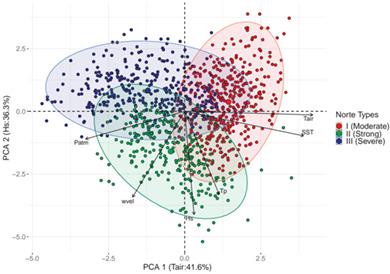当前位置:
X-MOL 学术
›
Int. J. Climatol.
›
论文详情
Our official English website, www.x-mol.net, welcomes your feedback! (Note: you will need to create a separate account there.)
Oceanic and atmospheric impact of central American cold surges (Nortes) in the Gulf of Mexico
International Journal of Climatology ( IF 3.9 ) Pub Date : 2020-07-30 , DOI: 10.1002/joc.6779 Jorge A. Kurczyn 1 , Christian M. Appendini 2 , Emilio Beier 3 , Atahaualpa Sosa‐López 4 , José López‐González 2 , Gregorio Posada‐Vanegas 4
International Journal of Climatology ( IF 3.9 ) Pub Date : 2020-07-30 , DOI: 10.1002/joc.6779 Jorge A. Kurczyn 1 , Christian M. Appendini 2 , Emilio Beier 3 , Atahaualpa Sosa‐López 4 , José López‐González 2 , Gregorio Posada‐Vanegas 4
Affiliation

|
Central American cold surge outbreaks, known as Nortes, are standard features of the Gulf of Mexico (GoM) climate, having significant oceanic and atmospheric impacts over the region that are essential for the marine ecosystem. Fifteen years of analysis of weather reports showed that Nortes occur within a 9 months window (September to May), with a total number of 24 ± 5 episodes per season. On average, there were 2.5 ± 1 events per month, lasting between 1 and 3 days with a maximum duration of 13 consecutive days. A Principal Component Analysis of 15 years of in situ observations identified the air temperature (41.6% of the explained variance) and the wave height (36.3%) as the two main drivers of these events impacts. Cluster Analysis to these same data categorized the Nortes into three types: Moderate, Strong, and Severe, based on the environmental impact caused in the GoM. These events tend to transit between categories as they lose strength while travelling to southern latitudes. Severe events are more frequent in the northwestern coast, occurring from January to March, whereas moderate events are more common in the middle of the GoM during September–December. Our results showed that Nortes increase the wind stress over the sea surface, rising the height and period of the waves over the southwestern and central GoM. Nortes also disturb the sea‐level and the surface currents, provoking high amplitude oscillations along the coasts, and accelerating and shifting the currents towards the southwest. Nortes bring cold, dry air that cools the ocean surface and the lower atmosphere and diminishes its relative humidity, which, together with the wind velocity increments, promote a positive sensible and latent heat flux maximized on the northwestern and western coasts.
中文翻译:

墨西哥湾中美洲冷浪(Nortes)对海洋和大气的影响
中美洲的冷潮暴发被称为Nortes,是墨西哥湾(GoM)气候的标准特征,在该地区具有重大的海洋和大气影响,对海洋生态系统至关重要。十五年的天气预报分析表明,北半球发生在9个月的时间范围内(9月至5月),每个季节总数为24±5次。平均而言,每月有2.5±1个事件,持续1至3天,最长持续时间为连续13天。对15年现场观察的主成分分析确定,气温(解释差异的41.6%)和波高(36.3%)是这些事件影响的两个主要驱动因素。聚类分析将这些相同的数据分类为Nortes分为三种类型:中等,强,重度的基础上,造成了墨西哥湾环境的影响。这些事件往往会在类别之间转换,因为它们在前往南部纬度时会失去力量。在1月至3月的西北海岸,严重事件更为频繁,而在9月至12月,中等事件在GoM中部更为常见。我们的结果表明,北非增加了海面上的风应力,增加了西南和中部GoM上的海浪的高度和周期。北部还会扰乱海平面和地表水流,在沿海地区引起高振幅振荡,并使水流加速并向西南移动。诺特 带入干燥的冷空气,以冷却海洋表面和较低的大气层并降低其相对湿度,这与风速的增加一起,促进西北和西部沿海地区的正感热潜热通量最大化。
更新日期:2020-07-30
中文翻译:

墨西哥湾中美洲冷浪(Nortes)对海洋和大气的影响
中美洲的冷潮暴发被称为Nortes,是墨西哥湾(GoM)气候的标准特征,在该地区具有重大的海洋和大气影响,对海洋生态系统至关重要。十五年的天气预报分析表明,北半球发生在9个月的时间范围内(9月至5月),每个季节总数为24±5次。平均而言,每月有2.5±1个事件,持续1至3天,最长持续时间为连续13天。对15年现场观察的主成分分析确定,气温(解释差异的41.6%)和波高(36.3%)是这些事件影响的两个主要驱动因素。聚类分析将这些相同的数据分类为Nortes分为三种类型:中等,强,重度的基础上,造成了墨西哥湾环境的影响。这些事件往往会在类别之间转换,因为它们在前往南部纬度时会失去力量。在1月至3月的西北海岸,严重事件更为频繁,而在9月至12月,中等事件在GoM中部更为常见。我们的结果表明,北非增加了海面上的风应力,增加了西南和中部GoM上的海浪的高度和周期。北部还会扰乱海平面和地表水流,在沿海地区引起高振幅振荡,并使水流加速并向西南移动。诺特 带入干燥的冷空气,以冷却海洋表面和较低的大气层并降低其相对湿度,这与风速的增加一起,促进西北和西部沿海地区的正感热潜热通量最大化。



























 京公网安备 11010802027423号
京公网安备 11010802027423号